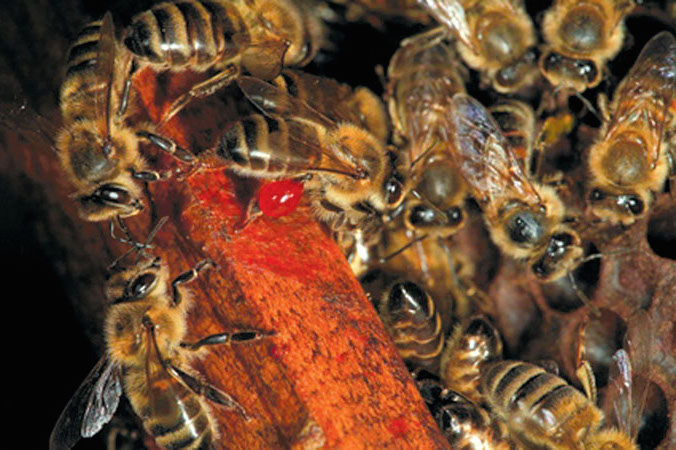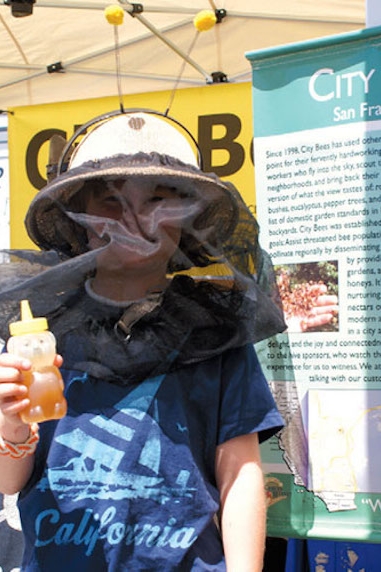The Rise of Hyper-Local Beekeeping and Honeys
The importance of honeybees for crop pollination and the precipitous drop in their population numbers have been well documented in recent media—including in an article by Meagan Riley-Grant in this issue of Edible Marin & Wine Country. Perhaps in response to all the media attention and out of concern for the future well-being of our food supply, the number of backyard beekeepers is on the rise. Fortunately for all of us that love the sweet “nectar of the gods” produced by these bees, honey, this also means that there is a lot more of it being produced right here in our own backyard.
According to Dave Peterson, a member of the Marin County Beekeepers Association (MCBA), as recently as seven years ago there were less than 20 active members in the group. Today, the MCBA boasts over 200 members. Peterson came to beekeeping when he found a feral honeybee hive living in a redwood stump on his property in Ross. His interest in bees piqued, he joined the MCBA, enlisted a mentor from the group and “took a split” [of bees] from a fellow member’s hive, thus beginning an unexpected journey into the delights of hive management and honey production.
Like many local beekeepers, Peterson is a hobbyist who relishes his work with bees and does not expect to earn a living from his efforts. “I hope that the hobbyist beekeeper is building back healthy bees, native pollinators,” Peterson said. But, as his expertise and experience have increased, so has the number of bees he keeps—a common phenomenon. What began as a “small box of bees” has grown into 20 hives spread across two apiaries — one at his home in Ross and another located at a business property in Corte Madera. Currently, Peterson harvests about 80 gallons of honey a year.
Mill Valley resident Keith Wedmore’s beekeeping roots go back generations; his grandfather, E.B. Wedmore, wrote A Manual of Beekeeping in the 1930s and Wedmore learned the skill as a child in Somerset, England. A few years ago he was asked to tend a hive at the Mill Valley Community Garden and that experience eventually led him to start his own hives—he currently has five with plans to double that this year—in the Tam Valley neighborhood of Mill Valley. He also installed a hive at the home of the mother of brothers Dave and Doug Canepa, the current co-owners of the Mill Valley Market. (The market was founded by the Canepa family in 1929.)
In 2010, the Canepas began an impressive local honey program at the market featuring small-batch, location-specific honeys sourced from within Marin County. Their offerings have included honeys harvested from the towns of Ross, Corte Madera, Tiburon- Belvedere and Mill Valley, including, of course, both Wedmore’s and Peterson’s honeys. The Canepas say they work hard to source these local honeys in order to have at least some available at the market year-round, but pointed out that bees don’t work on demand, or on assembly lines—one of the characteristics that make local, small production honeys so special is that they aren’t available all the time and you have to buy them when you see them for sale.
Efficient creatures, bees usually forage within a two to three mile radius. A label of “varietal” or “mono-floral” honey indicates that the nectar brought to the hive that produced the honey is confirmed by the beekeeper to be sourced from a specific plant. Beekeepers exert “control” over what their bees forage by strategic placement of their hives. Knowing that bees will always choose the shortest route to the juice, placing your hive next to a raspberry cane field will likely reward you with monofloral raspberry honey. The flavor of a honey labeled as “wildflower,” however, could vary wildly from one producer to the next and even from one jar to the next, depending upon the season and where the hives are placed. Generally speaking, orange blossom honey can only be produced in winter when citrus is in bloom, pumpkin blossom honey is created in late summer and early fall when pumpkin plants are flowering and blackberry blossom honey contains the essence of summer.
Spencer Marshall, an active beekeeper for over 40 years, believes there is absolutely a terroir of honey. “If a colony harvests nectar from the same type of plant, but that plant is raised in Napa or Sonoma, you can taste [the] soil difference in the honey,” he told me. Marshall, along with his wife and business partner Helene, began beekeeping with one “hobby hive.” The hobby evolved into a business when Helene walked into Toby’s Feed Barn in Point Reyes and Living Foods in San Anselmo one day and they both bought her honey on the spot. Marshall’s Farm Natural Honey, located in American Canyon, is no longer a hobby; they now manage about 500 hives in over 80 Bay Area locations at the peak of the production season.
The Marshalls, in partnership with other beekeepers, work with restaurants, hotels, wineries and other businesses, as well as private individuals, to help them manage their on-site apiaries, aka “bee yards,” and assist with—or perform—the extraction of their honey. The Marshalls typically manage the owners’ hives—or bring in their own—in exchange for what is known in the business as “yard rent.” “Yard rent” is an expansive term and encompasses all sorts of formally negotiated arrangements between beekeeper and landowner, from the barter of jarred honey in exchange for beekeeping services to the payment of a fixed fee per hive for bees brought in to pollinate orchards or other crops. In one such arrangement, the Marshall’s built and manage an apiary at the Culinary Institute of America at Greystone in Napa. For each hive managed, the school receives six gallons of the honey produced on-site and the Marshalls take the rest—the CIA gets a branded honey to sell at its store and a new varietal honey is born. “It’s win-win,” according to Helene.
In fact, many hobbyist beekeepers “take over” hives from friends or manage entire apiaries on neighboring properties using similar yard rent arrangements. Richard and Karen Hyde, who also sell their honey to the Mill Valley Market, got started when Richard helped a neighbor extract his honey. The Hydes started their own apiary a few years ago with a swarm caught in Tiburon and quickly expanded to five hives. “It’s fun to go catch swarms,” said Richard. “I’ve caught at least 10, but I had to stop my expansion at five hives.” The Hydes enjoy their bees—”We make time for it, it’s fun and helps offset Colony Collapse Disorder,” said Richard—and share most of their honey with friends, neighbors and family in less formal types of bee yard arrangements.
In fact, informal bee yard arrangements sometimes replace “legal” apiaries in communities where the laws have not kept up with the times. In the city of Mill Valley, for example, a city ordinance on the books since 1943 states: “A cow, stockyard or apiary is hereby declared to be a nuisance.” Liz Miller of the town’s Planning Department said enforcement of the ordinance, like others, “is complaint-driven.” In the last five years, no one has complained about anyone else’s bees, but the ordinance will not change unless the public demands it. Many towns, including Ross and Tiburon, have no ordinances on the books, nor does the county of Marin. If you plan to start keeping your own bees, do your research and, if you live in a town that has an ordinance against keeping bees, I suggest being being generous with your neighbors.
These and other “hyper-local” honeys can be found at farmers’ markets and other markets and specialty shops throughout our area. Pick some up and say a small “thank you” to the bees for their work in creating this sublime sweetener.
Honey is not just delicious; it is one of the more healthful types of sweetners. According to many doctors and scientists, including Ron Fessenden, MD, MPH and author of The Honey Revolution: Restoring the Health of Future Generations (World Class Emprise, LLC; 2nd edition, 2009), honey contains an ideal balance of fructose and glucose to create brain fuel and reduce metabolic stress. Unlike table sugar or high fructose corn syrup, which, when metabolized, create extra glucose and trigger an insulin response, a small dose of honey—one to two tablespoons—does not elevate blood sugar levels due to the liver’s ability to metabolize honey’s lower levels of fructose and remove glucose from circulation. Additionally, regular honey consumption, harvested from hives located close to where you live, has been found to lessen sensitivities to allergens in the environment.
RESOURCE LIST:
Marin County Beekeepers: www.marincountybeekeepers.org
Sonoma County Beekeepers Association: www.sonomabees.org/index.html
beekind: Retail store selling honey and other bee products and beekeeping supplies and an informational hub for regional beekeepers. Their main location in Sebastopol with a kiosk in the San Francisco Ferry Plaza Building. www.beekind.com
Dave Peterson: Dave is happy to provide people thinking about getting into beekeeping with a primer he has created called “Getting Started.” dpeterson307@aol.com
Mill Valley Market: www.millvalleymarket.com
Marshall’s Farm Natural Honey: www.marshallshoney.com






